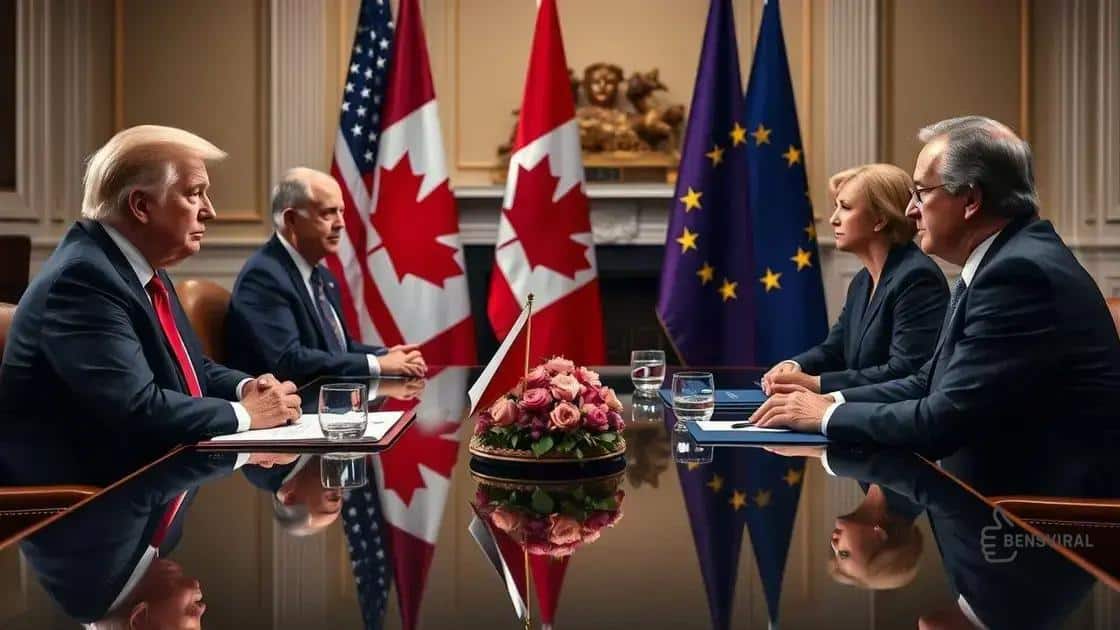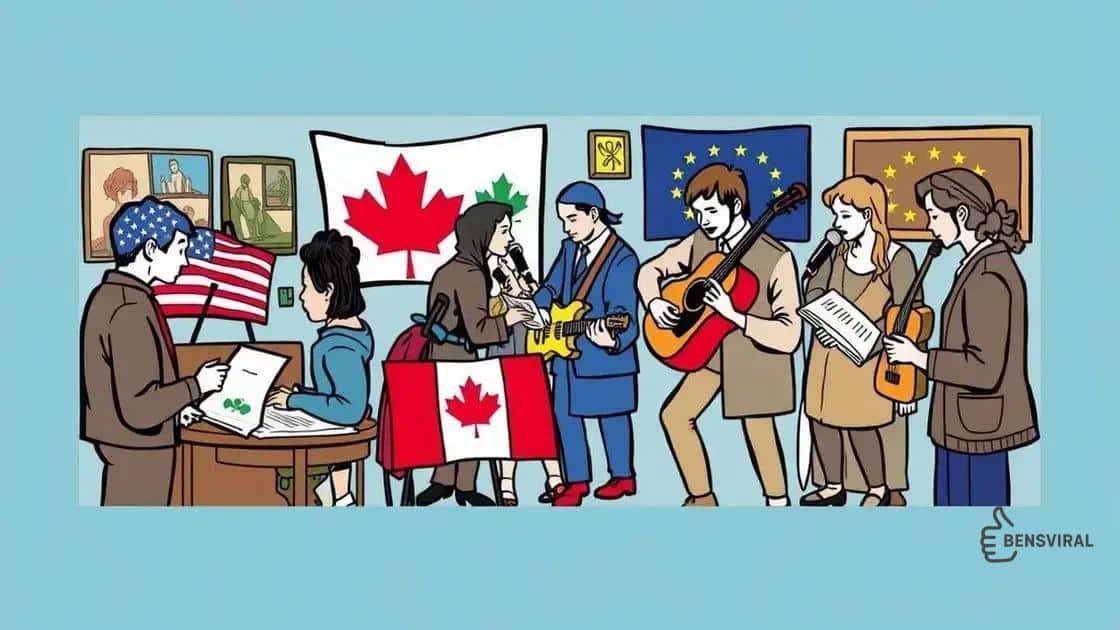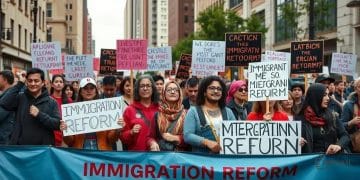Tensions in U.S. diplomacy with Canada and European nations

Tensions in U.S. diplomacy with Canada and European nations stem from trade policies, cultural differences, military cooperation, and shifting political landscapes, which collectively impact economic and security relationships.
Tensions in U.S. diplomacy with Canada and European nations have become more pronounced in recent years. But why is this happening? It’s a vital topic that affects not just politics, but also everyday interactions and trade.
Historical context of U.S.-Canada relations
The historical context of U.S.-Canada relations plays a crucial role in understanding the current challenges in diplomacy. Over the years, these two nations have shared a strong bond, but tensions have also arisen. This relationship is rooted in shared history, geography, and values.
Early Relations
Initially, relations between the U.S. and Canada were influenced by colonial ties. Both countries were part of the British Empire. The American Revolution caused significant changes, leading to the establishment of the United States as a separate nation. Canada remained a British colony, setting the stage for complexities in their interactions.
20th Century Developments
In the 20th century, the relationship deepened, particularly during World War I and World War II. The U.S. and Canada worked closely together to support war efforts, highlighting their mutual interests. The post-war era saw the two nations collaborating on various initiatives, including trade agreements and defense policies.
- Increase in trade between the two nations.
- Joint military initiatives during conflicts.
- Shared approaches to environmental issues.
However, challenges have surfaced. Issues such as trade disputes, environmental policies, and immigration have sometimes strained their relationship. Despite these challenges, both nations continue to navigate these issues with a spirit of collaboration.
Recent Trends
In recent years, the relationship has faced new tests due to changing political landscapes. The U.S. has adopted policies that impact trade and immigration, leading to concerns in Canada. The ongoing debates surrounding climate change also require both nations to rethink their approaches to collaboration.
As they face these contemporary challenges, it is essential to recognize the long-standing ties that bind them. Understanding the historical context of U.S.-Canada relations can provide valuable insights into how both nations can move forward together.
Impact of trade policies on diplomacy
The impact of trade policies on diplomacy between the U.S. and Canada, as well as European nations, is significant. Trade agreements can strengthen alliances but also create friction. Understanding how these policies shape diplomatic relationships is essential for grasping the overall dynamics.
Trade Agreements and Alliances
Trade agreements, like NAFTA, have historically been a cornerstone of U.S.-Canada relations. When countries engage in trade, they build economic ties that enhance their diplomatic connections. The more interdependent countries are economically, the more likely they are to cooperate politically.
Consequences of Protectionism
However, when protectionist measures are introduced, tensions often rise. Tariffs may lead to retaliatory actions, distorting relationships. This situation occurred recently when the U.S. imposed tariffs on aluminum and steel, prompting Canada and Europe to respond with their own tariffs.
- Increased costs for consumers and businesses.
- Potential job losses in affected industries.
- Strained diplomatic relations due to economic disputes.
As negotiations unfold, it becomes important to analyze how these policies can reshape dialogues and partnerships. Each nation’s economic strategy influences their diplomatic stance, especially in critical moments.
Trade policy changes often generate debates within countries. Stakeholders, including businesses and labor unions, may have conflicting interests, making negotiation processes more complex. The balance between protecting domestic interests and supporting international cooperation is delicate.
Future Trends in Trade Diplomacy
Looking ahead, the impact of trade policies on diplomacy will likely evolve with emerging global challenges. As nations address climate change and technological advancements, new trade agreements may reflect a shift in priorities.
Ultimately, the way countries manage these policies can either forge stronger alliances or create new conflicts. Striking a balance is key to maintaining healthy diplomatic relations.
Cultural ties and their role in conflict

Cultural ties between countries often influence their diplomatic relations. In the case of the U.S., Canada, and European nations, shared values and histories shape interactions significantly. When cultural connections are strong, cooperation increases, but differences can lead to conflicts.
Historical Roots of Cultural Ties
The historical ties between the U.S. and Canada stem from their common colonial past. Both nations share a language and similar democratic values, which create a foundation for mutual understanding. Additionally, European nations have a significant cultural impact on both North American countries.
How Culture Affects Diplomacy
Cultural diplomacy plays a crucial role in resolving conflicts. When nations collaborate through art, education, and exchange programs, they build bridges. For instance, cultural festivals showcasing each other’s heritage can foster goodwill and dispel misunderstandings.
- Increased empathy and understanding among nations.
- Enhanced communication through shared cultural events.
- Positive perceptions that influence policy decisions.
However, cultural differences can also lead to friction. Misunderstandings arising from differing norms and values may spark conflicts. For example, varying attitudes toward human rights can strain diplomatic ties, leading to disputes over international policies.
The rise of nationalism in some countries has also affected cultural ties and, consequently, diplomacy. When nations prioritize their unique identities over shared values, tensions can escalate. This makes addressing conflicts more challenging.
Promoting Positive Cultural Exchange
To mitigate conflicts, it’s essential to promote positive cultural exchanges. Initiatives that focus on education and mutual respect can enhance understanding. Engaging youth through exchange programs encourages the next generation to appreciate diverse cultures.
In summary, the role of cultural ties in shaping diplomacy cannot be understated. By fostering connections and addressing differences, countries can work towards more harmonious diplomatic relations.
Military cooperation and challenges
Military cooperation among the U.S., Canada, and European nations is crucial for ensuring collective security. Over the years, joint exercises and training initiatives have enhanced interoperability among forces. These collaborations help nations respond effectively to global threats.
Historical Context of Military Alliances
Historically, military cooperation began after World War II, leading to the establishment of organizations like NATO. Through NATO, the U.S. and Canada, together with European allies, committed to mutual defense. This commitment reinforces the idea that an attack on one is an attack on all.
Joint Operations and Training
Ongoing joint military operations strengthen relationships. Exercises such as Trident Juncture and Rim of the Pacific (RIMPAC) involve multiple nations working together. Such exercises promote trust, improve strategies, and enhance readiness.
- Strengthened communication among military leaders.
- Improved tactical skills through shared training.
- Development of rapid response capabilities.
However, challenges arise in military cooperation. Differences in defense spending and varying national priorities can lead to disagreements. Some nations may feel pressured to increase military budgets to meet alliance expectations, causing tension within the group.
Additionally, political changes can impact military agreements. New leaders or shifting public opinions may lead to reassessments of defense commitments. For example, changes in U.S. foreign policy have, at times, created uncertainty for its allies.
Future Challenges in Military Cooperation
Looking forward, the nature of threats may evolve, requiring adaptation in military strategies. Cybersecurity and terrorism are paramount concerns. Nations must collaborate on intelligence sharing and cyber defense to counter these challenges effectively.
Ultimately, successful military cooperation relies on understanding and addressing these challenges. A united front ensures that each nation’s security interests are preserved in a complex global landscape.
Future outlook for U.S. relations with Europe
The future outlook for U.S. relations with Europe is an important topic as global dynamics shift. These relationships affect trade, security, and cultural exchange. Understanding the anticipated changes can help identify opportunities and challenges for both sides.
Shifting Political Landscapes
As political parties change in both the U.S. and European nations, foreign policy priorities can also shift. New administrations may bring different approaches to diplomacy. For example, recent elections have raised questions about the U.S.’s commitment to NATO and its stance on international agreements.
Economic Cooperation
Economic ties remain a key aspect of U.S.-European relations. Trade agreements, like the proposed U.S.-EU trade talks, aim to enhance economic cooperation. This collaboration can lead to increased investment and job creation on both sides. However, fluctuations in trade policies may introduce uncertainties.
- Stronger partnerships through shared economic interests.
- Focus on technological advancements and innovation.
- Increased importance of digital economy regulations.
Cultural ties also play a significant role in shaping the future of these relations. Exchange programs and collaborative initiatives can foster a sense of unity. As younger generations value globalism, understanding and cooperation may deepen.
Security Challenges
Security remains a priority in U.S.-European relations. Ongoing issues such as terrorism and cybersecurity threats require collaboration. Joint military exercises and intelligence sharing can enhance collective security efforts. Adapting to emerging threats is crucial for maintaining strong ties.
Moreover, climate change is becoming increasingly relevant in diplomatic discussions. Both the U.S. and European nations must work together on environmental policies. Cooperation in this area could not only improve relations but also address global challenges.
In summary, the future outlook for U.S. relations with Europe will depend on political changes, economic cooperation, and shared security concerns. By focusing on collaboration, both parties can navigate the complexities of international relations effectively.
FAQ – Frequently Asked Questions about U.S. Relations with Canada and Europe
What are the main cultural ties between the U.S. and Europe?
The U.S. and Europe share a rich heritage, including language, democratic values, and historical events that foster strong cultural connections.
How do trade policies affect U.S.-European relations?
Trade policies can strengthen alliances through agreements or create tensions through tariffs and protectionism, impacting diplomatic relations.
What role does military cooperation play in these relationships?
Military cooperation, such as joint exercises and NATO commitments, enhances security and fosters trust between nations.
What challenges are faced in U.S.-Canada relations?
Challenges include political changes, trade disputes, and differing priorities that can cause tensions in diplomatic efforts.






